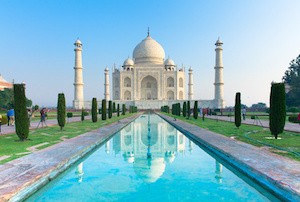 One of the greatest things about kiwis is our laid back attitude – we are a pretty laid back bunch, which sometimes shows in the way we dress! While there’s not many occasions while on holiday in New Zealand that a pair of shorts, t-shirt and jandals aren’t appropriate, the same is not always the case overseas.
One of the greatest things about kiwis is our laid back attitude – we are a pretty laid back bunch, which sometimes shows in the way we dress! While there’s not many occasions while on holiday in New Zealand that a pair of shorts, t-shirt and jandals aren’t appropriate, the same is not always the case overseas.
When you are planning an overseas trip to a destination where the dress code is likely to be more conservative (temples, shrines, cathedrals, memorials, ancient sites or other sacred places,) or where the country as a whole has different expectations of clothing, check with your travel advisor or other professional about what is considered appropriate attire.
The way you dress is an important part of respecting local customs, standards and expectations, and may have an impact on being admitted to sacred sites, attract unwanted attention or experience delays. You will also blend in better with the locals, making you less of a target for pick pockets and con artists.
Below is a list of some popular tourist destinations, along with guidelines for what you may be expected to wear. As a general rule, sacred or significant sites will often require a more modest dress code than usual. Even in warmer climates, ensure you have a looser fitting pair of long trousers, a shirt with a collar and long sleeves and closed toed shoes. Pack your best socks for travel, and you may need to remove your shoes frequently! If you have a small foldable bag to pack your shoes into, it is a good idea. Scarves or pashminas can double as headwear where required, or for a warm layer at other times.
Taj Mahal, India
The Taj Mahal is a mausoleum, with no defined dress code, however it is advisable to cover up out of respect. Most tourists choose to wear pants, maxi-dresses or harem pants.
Machu Picchu, Peru
As tourists walk to Machu Picchu, travellers generally wear hiking gear and boots. The temperature varies widely, so it is important to dress in comfortable layers.
Tiananmen Square, Beijing, China
You can dress as you wish in Tiananmen Square, however, you will need to be ‘smart casual’ and remove your hat to enter the Mausoleum of Chairman Mao.
Parthenon, Athens, Greece
Visitors to the Parthenon are welcome to wear whatever they like, but it isn’t suitable for delicate or high heeled footwear – the site itself is rocky and much of the surrounding areas are unpaved.
Notre Dame Cathedral, Paris, France
The French are fairly relaxed when it comes to dress codes. Tourists usually wear everyday clothing, including singlets and shorts during the summer months. However, it is a good idea to have a shawl or scarf handy, just in case.
Pyramids of Giza, Cairo, Egypt
In Cairo, outside of the hotels that cater to international visitors, the locals will expect you to dress conservatively (in the hotels, western dress is fine). This expectation applies to both men and women, so pack clothing which is long, loose fitting clothing and covers your arms. In the coastal areas, shorts and sleeveless tops are more acceptable, but even men should avoid them in the city.
Sheikh Zayed Grand Mosque, Abu Dhabi, United Arab Emirates
There is a detailed list of rules for this sacred place, and those not dressed appropriately will not be allowed to enter. Wear modest, conservative, loose-fitting clothing with long sleeves, long skirts and trousers. No transparent clothing, shorts, tight clothing, swimwear or beachwear are permitted, and women must wear headscarves and a traditional robe (abaya), which can be provided on site.
St. Peter’s Basilica, Vatican City
The guards on duty use some discretion, but this is a holy site, so it is better to be safer than sorry. Dress conservatively – bring a shawl and change of pants or long pants and a collared shorts to visit.
Petra World Heritage Site, Wadi Musa, Jordan
The ancient sites at Petra don’t have a defined dress code, but Islamic traditions encourage a modest dress code (loose fitting clothing, headscarf and covered shoulders).
Church of Our Saviour On Spilled Blood, St. Petersburg, Russia
You are free to explore the grounds of the Church of Our Saviour On Spilled Blood, but there are expectations regarding clothing. Women are advised to wear a head covering but otherwise smart casual attire is okay.
Ho Chi Minh Mausoleum, Hanoi, Vietnam
There is a strict dress code at the Ho Chi Minh Mausoleum. Men are expected to wear a shirt with long pants and women should dress with modestly. You will be asked to remove your hat and large bags may need to be stored – no cameras are permitted.









Bill Leathwick - 9 years ago
Some years ago I was leading a tour party overseas.When we arrived at St Peters in Rome we were stopped by a guard and one of our party was refused admittance as he was wearing walk shorts.. actually very conservative shorts I might add. A lady in our group was wearing a sunfrock (it was a very hot day) and had to put a handkerchief over her shoulders. Fair enough I suppose..but what about those brazen nude statues INSIDE the Cathedral? tut tut!!!!!! Keep up the good work Grownups.( kiwi actor.)